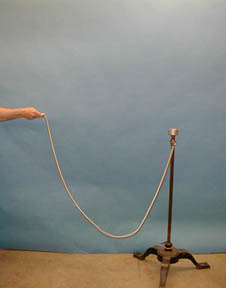Demos: 1S-15 Transverse Wave Motion (Spring)

One end of a long helical spring, approximately 1/2” in diameter, is attached to a heavy stand. The other end is held in the hand and the spring is stretched slightly. A jerk is given transverse to the spring causing a wave pulse to propagate. Different wave pulse speeds can be seen by changing the tension in the spring.
Directions: Stretch the spring lightly and give it a transverse jerk. Pull the spring tighter to produce a faster wave pulse speed.
(To show standing waves, carefully move the end up and down and with a little practice, you can generate a variety of standing wave modes.)
Suggestions for Presentation: The wave pulses move reasonably fast, so ask the students to concentrate on the speed to see if they can tell the difference in speeds when the tension is changed. Ask them to predict whether the speed will increase or decrease if the tension is changed.
Note: Because of the reflection at the end, it is not feasible to try to establish any traveling wave in the spring. It is best to stay with the pulse, or if you wish to extend it to standing waves, you can set up some nice patterns as per the directions above.
Applications: None in particular. This is just a basic demonstration of transverse wave pulses.
Last Updated: Nov 30, 2023 11:25 AM